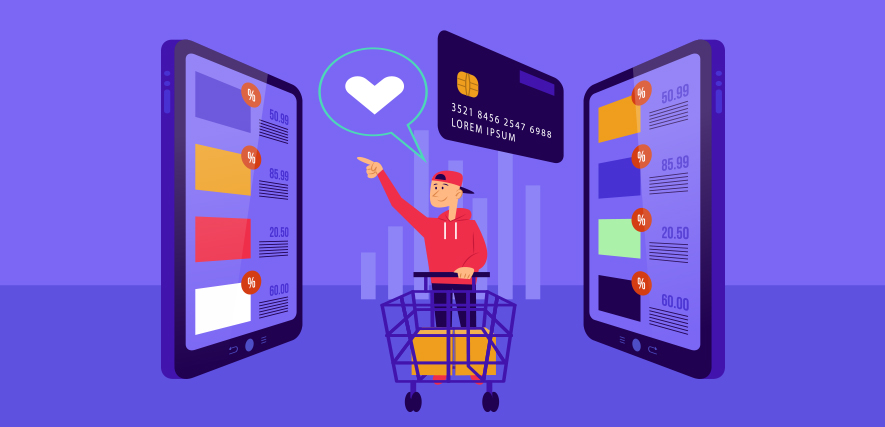The year 2020 brought a lot of tension and turmoil in the entire world, putting almost every industry in haywire. Owing to the enormous amount of uncertainty, every strategy was put to a halt as the world stood standstill. Certainly the digital activities gained momentum by leaps and bounds with almost everyone spending time on their device much more than usual. According to Fiber, the total internet use was increased by 50% to 70%, ever since the pandemic struck.
From attending online classes, being part of video conference calls to shopping, seeking medical treatment, and watching movies, the masses turned to technology for all they needed. This led to an out of the ordinary spike in data usage. Where physical stores were closed down, online stores were the go-to source for day-to-day needs of the people. Consumers and their buying behavior took seismic shifts, with more of them hunting for the safe and trusted product on digital platforms. Well, social media played a lead role here, as 40% of the US population is relying upon social media for their buying decisions, as reported by GlobalWebIndex.
The scenario has certainly led to the surge in the number of opportunities for businesses and marketers to engage in influencer marketing, which involves influencers, their huge fan-following, their niche areas, and the amount of trust they generate among them with their content – videos, texts and images.
Interestingly, 89% of marketers say that the return on investment with influencer marketing is much more than other marketing mediums.
Influencer marketing is certainly becoming the cornerstone of brand marketing strategies.
Table Of Content
Shifting Perspectives of Brands & Buyers

The recent pandemic has changed the perspectives of both brands and buyers, respectively. While brands look for generating the content that is more sensible and sales-oriented rather than superficial, the consumers also search for all that is not over-marketed, and is rather unfeigned and trusted. Influencers cater to demands, and meet the expectations of both the brands and consumers. They allow the brand to present their product or service offerings in a more genuine way, as today’s consumer does not expect superfluous claims and rather expects more realistic offers that would really serve their purpose well. Therefore, partnering with influencers is certainly taking brands to the next level, and will continue to do so in the times to come.
Especially these days, when people are still dealing with economic setbacks led by job losses, influencer marketing allows the brand to develop a good image so that when the buyers retain sound financial status, they know what to trust and choose.
Know about Influencer Marketing – You Got to be Doing it Right, Avoiding Top 6 Blunders.
Innovative Content & Magnified Reach

When a brand markets itself by producing ads, it may or may not convince the people for sounding very sale-sy! While an influencer is a third party source for the brand that can market it in unique innovative ways, which the brand itself may not even have thought of. An influencer is the bridge between the brand and buyers, who presents self as a customer or buyer, whom the viewers can clearly associate with. The content is made in perspective of the buyer’s own experiences and reviews, and therefore, looks unique and far from a seller’s viewpoint. Such type of content is more accepted by the people. Also, it reaches far and wide depending upon the influencer’s own fan-following.
A study suggests that the most effective platforms for influencer marketing are blogs, Facebook, YouTube, Instagram, Twitter and other social media platforms.
The Advent of Realistic Video Content

Patience is what lacking among the people today, and they prefer watching videos rather than going through texts. Videos grab attention instantaneously, and generate 1200% more shares than images and text altogether. Today, people are watching more videos on digital platform, especially the ones that are made by influencers whom they follow and like to see almost every day.
The ease in video making right with the devices they carry has made it extremely effortless for the influencers to post the impactful content. Owing to the increase in the number of video viewers, Facebook, Instagram and YouTube have already augmented their video making features to become the most video supportive platforms. The video content from influencers is the most sought after content on all these social platforms, as they are looked upon as more authentic being made extemporaneously. In fact, they look more genuine than the ones that are scripted and shot professionally. Even if the videos are suitably edited, they appeal more to the viewers. The imperfections in the ones made by influencers are rather considered to be more relatable by the masses. They look more like personal reviews than ads, and so they build much stronger connection than regular ads. That’s where the brands can leverage this form of marketing.
Today’s consumer craves for realism with which they can connect. When realism is paired with humor, they become even more powerful. Influencer marketers understand this fact and many of them carry this skill too!
It’s All About Authenticity – Brand or Influencer

Authenticity matters, whether it is about a product, brands or even an influencer!
Today’s consumer has become way smarter than ever before, as they identify the campaigns that paid and the ones that are genuine. They take no time to abandon the campaigns that look unrealistic and sales-oriented even by a bit. Therefore, the brands look for genuine and performing influencers for partnering. On social media, where every influencer claims to be genuine, the brands should consider the influencers that have organic fan-following. Alongside, they should develop a brand ambassador program that has clearly outlined goals including – increased sales, brand awareness, website traffic, and lot more.
Apart from this, to determine the authenticity of influencers with his genuine followers, an ambassador program can we quite effective, as it involves only the bona fide influencers who have their profile and professional experience duly verified. Tracking the data of campaigns allows the brands to identify the right influencers for their ambassador program.
So, What’s Next & How to Go About It?
The burgeoning industry of influencer marketing is certainly making waves in the business market and among the marketers too.
With awakened consumers demanding more transparency in the fast maturing influencer marketing industry, new rules and regulations are being implemented by the countries, respectively. Like, for example, in the US, the Federal Trade Commission has been updating the guidelines time to time, with more stringent clauses.
Considering these regulatory guidelines, the brands should make sure that the influencers they are tying up with are honest-to-goodness and knowledgeable as well. They should aim at generating long-term partnerships with them, which builds a long-term trust among the people too.
